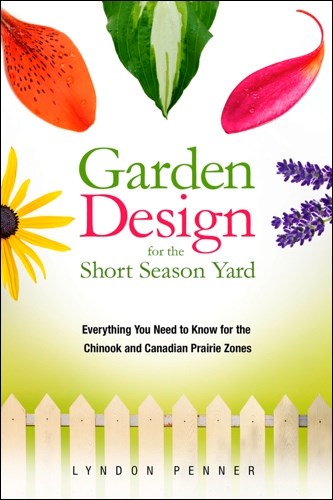“A good garden is always the result of good planning,” says Lyndon Penner at the start of his new book, Garden Design for the Short Season Yard. I couldn’t agree more. Too often, gardens are haphazard affairs where plants arrive and get planted without little thought on how they relate to each other in terms of colour, shape, texture, size and function. The result can be boring, uninspiring, more maintenance than intended and soulless.
Penner is passionate about gardening and it shines through in his sometimes rambly but always entertaining style. This book is written for prairie gardeners who have to contend with ultra-low temperature, chinooks and variable soils. And during our short season, we need to be able to maximize the beauty of our garden spaces and extend our enjoyment beyond the four maybe five months of peak growth. And that can be achieved with purposeful and thoughtful design.
In the first section, Practical Considerations, Penner starts out convincing us that taking the time to design a garden is worthwhile, despite the initial investment in time and money. Part of the practical considerations is to take inventory of existing conditions: plants, soil, water, climate and light conditions. And as he describes these conditions, he offers plant suggestions that will thrive under limiting conditions such as shade, drought and heavy soils.
Penner instructs us to be pragmatic and recognize that, despite the love and labour that we may pour into our gardens, there are biological challenges to be faced: disease, pests and pets. But he describes strategies that will reduce some of these challenges such as fostering pests’ natural enemies to prevent pest outbreak.
In Design Considerations, Penner discusses popular trends and, with a bit of imagination and plant smarts, he suggests how to adapt those trends to suit Prairie conditions. He also touches on theme gardens and describes several of the more popular as well as a few unusual ones. But at the heart of garden design is the basic elements of design: lines and curves, scale, patterns and repetition, variety, rhythm and unity, balance, surprise and movement. Penner defines and offers examples of how these elements can be used and combined. Separate chapters cover concepts like negative space, focal points and how to use and blend colours.
Now that you have a good grounding in the basic concepts Penner feels it’s time for Drafting Your Design in the third section. However, this is where I feel the book falls short. There has been little to no discussion on designing for function such privacy needs or framing desirable views from within the garden and from inside your home. Nor has the importance of identifying leisure space (play spaces for children and areas for adult social interaction), controlling or directing wind and taking into account utilities (e.g. overhead wires) been covered in any detail. In other words, how you intend to use the space and dealing with non-plant challenges should be just as important as how beautiful the garden is.
Penner has also not discussed the “how” of design: e.g. how to represent existing and planned trees, shrubs, perennials; how to label plants and structures; how to show the scale; how to indicate exposure (i.e. North arrow) and so forth. In short, the section on how to accurately and correctly draft out your plan has been misplaced.
Despite these shortcomings, Penner has done a good job of covering many of the important design considerations and concepts, offers excellent advice on plant selection, describes interesting garden styles and themes and inspires us to be bold. I would pair his book with one that covers the mechanics of design since the “how” is not specific to any region whereas what Penner writes about is Prairie-centric with unique design challenges and opportunities.
Garden Design for the Short Season Yard is available in many local garden centres and book stores.
— This column is provided courtesy of the Saskatchewan Perennial Society (www.saskperennial.ca; hortscene@yahoo.com). Check out our Bulletin Board or Calendar for upcoming garden information sessions.



